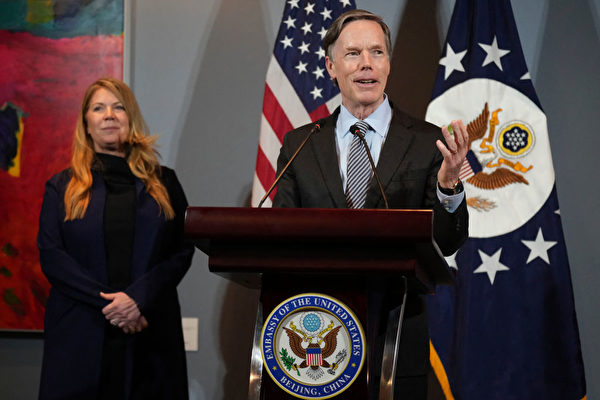In the past two years, American ambassador to China, R. Nicholas Burns, has traveled to several provinces and cities in China by train. Recently, he was interviewed by the Financial Times to discuss the strangest scenes and experiences he encountered while working in China.
When Burns took office, he faced the peak of China’s strict COVID-zero policy, which delayed his arrival by more than a year compared to the normal start time.
In March 2022, Burns and his wife Libby arrived in Beijing to a scene reminiscent of the movie “Star Wars.” In the midst of a sandstorm, they were greeted not by diplomatic hosts, but by dozens of Chinese health workers dressed head to toe in white protective suits (nicknamed “Big Whites”).
They had to pass through a boarding bridge and enter a room wrapped in plastic from floor to ceiling, where they underwent nucleic acid testing. Burns couldn’t understand what the Big Whites were saying because they were wearing face masks and thick protective gear, making their faces invisible.
“It was the strangest scene I have ever experienced,” he told the Financial Times.
For the next 21 days, Burns and his wife were quarantined in the ambassador’s residence without seeing a single person. They were not allowed to walk around the compound because of the risk of security personnel getting infected.
In his first nine months in office, Burns was quarantined for a total of 45 days.
Burns likened his role in China to that of the American ambassador to Moscow during the height of the Cold War in the 1950s and 60s. Perhaps the isolation brought by China’s zero-COVID policy was more pronounced for Burns than for his predecessors.
The bizarre drama took an even stranger turn. On December 9, 2022, Chinese leader Xi Jinping suddenly announced the end of the dynamic zero policy, lifting most of the epidemic restrictions. Over the next two months, a large number of Chinese citizens rapidly became infected and even died.
Within the staff of the U.S. embassy, including family members, 80% quickly became infected, totaling nearly a thousand people.
Burns, who previously worked as a scholar at the Kennedy School of Harvard University, has always been cautious and polite in his language. The contrast between his personal image and his role as a professional diplomat responsible for handling the tense and high-risk relationship between the United States and China seems striking.
Especially with Xi Jinping’s control over the Communist system surpassing that of any previous leader, Burns’ work became even more challenging. For instance, after then-Speaker of the House Nancy Pelosi visited Taiwan, Burns faced eight protests from the Chinese side, each lasting two to four hours.
“They strongly protested, and I defended Pelosi’s right as the equivalent of a U.S. government department head to visit Taiwan,” Burns said.
In an interview with the Financial Times, Burns said, “The suppression in China now is higher than at any time in the past few decades.”
He explained that it is now difficult for the U.S. and China to engage in informal dialogues in diplomacy. He said that now there are only formal “negotiation diplomacy,” with little room for informal dialogues over dinner or drinks, which have become “few and far between.”
In 2023, both the Chinese Foreign Minister, Qin Gang, and the Defense Minister, Li Shangfu, went missing. No one knew their whereabouts, only that many Chinese officials were dismissed on corruption charges. Current Chinese officials are even less willing than their predecessors to exchange informal anecdotes with foreign diplomats.
U.S. Ambassador to Japan, Rahm Emanuel, boldly questioned Li Shangfu and other Chinese officials’ whereabouts on social media platform X, attracting media attention.
In a recent interview with “The Wire,” he said, “Now, the facts about China may be painful, but they are the facts.”
The ambassador to Japan praised Burns’ work, calling him a “good cop” while he played the role of a “bad cop.”
“John F. Kennedy spoke of a ‘long twilight struggle’,” Burns told the Financial Times, “This may be the 21st-century version, where we must compete but also maintain contact to reduce the likelihood of conflict.”
Burns added, “We are engaged in a battle of ideas with Beijing – our democratic values versus their authoritarian mindset. We fight this battle every day, trying to defend our vision of the future.”
Last November, the top leaders of the U.S. and China met in San Francisco, signaling a slow resumption of government-level exchanges, though the restoration of civilian relations remains a daunting task. Before the outbreak, there were 345 flights between China and the U.S. every week. Currently, fewer than 100 flights have been restored.
In 2020, there were 15,000 American students studying in China, but now only 800 remain. Bilateral tourism has plummeted from millions to just thousands.
Last week, four exchange teachers from Iowa were stabbed in Northeast China, yet the reason remains unknown. Burns later spoke with the injured teachers and publicly expressed anger and deep concern about the incident. One of the teachers has returned to the U.S. with the help of the embassy.

